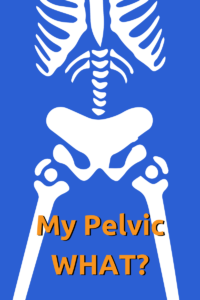Maybe you’ve had problems with your low back, hips, or abdomen and someone told you to work on strengthening your pelvic floor.
What in the world is the pelvic floor anyway?!?! 
The pelvic floor is a group of muscles that extend from your pubic bone in the front to your tailbone in the back. The muscles are shaped like a sling or a hammock and support the bladder, rectum, and urethra, as well as the uterus and vagina in women and the prostate and seminal vesicles in men. The term ‘pelvic floor’ is, in fact, a very fitting name. It lies roughly in a horizontal orientation and closes off the opening that would otherwise allow the pelvic and abdominal contents above it to fall through. It is the horizontal load-bearing muscle in the human body!
What are the functions of the pelvic floor?
The pelvic floor serves numerous functions. First and foremost, the pelvic floor is the center of gravity for your body. It is the place where movement is initiated and is essential to your overall well being. The pelvic floor makes a fundamental contribution to your core stability (Male Pelvic Floor, 2012). In other words, it allows coordination between the pelvic floor and abdominal, hip and back muscles. Aside from movement and stability, the pelvic floor serves the vital role of support. The bladder, rectum, urethra, uterus, and vagina (women) and prostate and seminal vesicles (men) are all organs directly supported by the pelvic floor. Women with a weak pelvic floor may be subjected to pelvic organ prolapse. That means a pelvic organ, such as your bladder, drops (prolapses) from its normal place in your pelvis and pushes against the walls of your vagina (Varuna & Ravinder, 2008).
In addition to supporting the body’s vital pelvic organs, the pelvic floor muscles regulate our continence. The muscles of the pelvic floor regulate the opening and closing of the urethra ( the tube that excretes urine) and anus ( the tube that excretes stool). Your pelvic floor also plays a vital role in sexuality. A strong and healthy pelvic floor will improve sexual response and heighten sexual pleasure (Male Pelvic Floor, 2012).
Why should we care about our pelvic health?
Dr. Peter Petros describes the pelvic floor is an interrelated system of organs, muscles, nerves, and connective tissue structures. To improve the function of the pelvic floor, we must restore the structure (Petros, 2010). Pelvic floor rehabilitation describes an approach to improving the strength and function of the muscles that support your pelvic floor.
Maybe your pelvic floor is weak causing problems such as pelvic organ prolapse or incontinence? Maybe your pelvic floor muscles are too tight and are causing you problems with your sex life? Whatever the case may be, our pelvic floor is vital to our health and we NEED to care about it.
What are common problems associated with the pelvic floor?
Common signs that can indicate a pelvic floor problem include:
- Leaking urine when you laugh, cough, or sneeze (stress incontinence)
- Not making it to the bathroom in time (urge urinary incontinence)
- Constantly feeling like you have to go to the bathroom (urinary urgency)
- Accidentally losing control of your bladder or bowels
- Pelvic organ prolapse (when a pelvic organ such as your bladder drops (prolapses) from its normal place in your pelvis
- Pain in your pelvic area
- Painful sex
How are pelvic floor problems treated?
Pelvic floor specialists have specialized training in the anatomy, function, evaluation, and assessment of the pelvis and its corresponding muscles, bones, and soft tissue. Many conservative, non-surgical treatment options exist for pelvic floor disorders. Treatment for pelvic floor disorders depends highly on the individual’s problem. When the pelvic floor is weak, the focus is on strengthening. Pelvic floor muscle training, otherwise known as Kegel exercises, are the foundation for strengthening the pelvic floor. Nearly 60% of individuals perform a Kegel exercise incorrectly, therefore, it is important to consult with your provider to learn the correct technique (Kandadai, O’Dell, & Saini, 2015). Vaginal weights and vaginal stimulation units are both modalities that can help accomplish pelvic floor muscle training. When the pelvic floor is too strong, the focus is on relaxation. Pelvic floor rehab utilizing various relaxation techniques is a conservative first-line therapy. Biofeedback can help teach the pelvic floor muscles how to relax. Additional relaxation techniques may bowel and bladder retraining regimens, stretches to open the pelvic floor, breathing techniques, ‘reverse’ Kegel, yoga, and meditation (Faubion, Shuster, & Bharucha, 2012).
Help is available
If you think you are suffering from a pelvic floor disorder, please seek help right away! 1 in 5 Americans suffers from some type of pelvic floor dysfunction at some point in their life. Millions of Americans are suffering from pelvic floor dysfunction, yet for most of those individuals, the disease goes unidentified and untreated (Pelvic Floor Dysfunction, Men’s and Women’s Health and Physical Therapy). Become empowered by knowing there is help!
Sources
Kandadai, P., O’Dell, K., & Saini, J. (2015). Correct performance of pelvic muscle exercises in women reporting prior knowledge. Female Pelvic Medicine and Reconstructive Surgery, 21, 135-140.
Faubion, S., Shuster, L., Bharucha, A. (2012). Recognition and Management of Nonrelaxing Pelvic Floor Dysfunction. Mayo Clinic Proceedings, 87, 187-193.
Male Pelvic Floor. Retrieved November 10th, 2017 from http://www.malepelvicfloor.com/
Pelvic Floor Dysfunction, Men’s and Women’s Health and Physical Therapy. Retrieved November 11th, 2017 from http://www.mccc.edu/~behrensb/documents/pelvicfloordisorderpresentation.pdf
Varuna, R. and Ravinder, K., (2008). Pelvic Floor Anatomy and Applied Physiology. Gastroenterology Clinics of North America, 37, 493-509.
Petros, P. (2010). The Female Pelvic Floor, Function, Dysfunction, and Management According to the Integral Theory. Germany: Spinger-Verlag Berlin Heidelberg.

